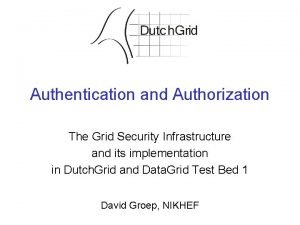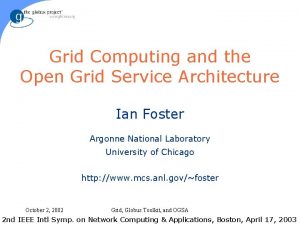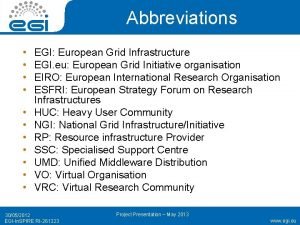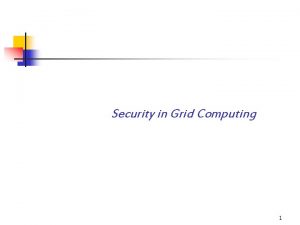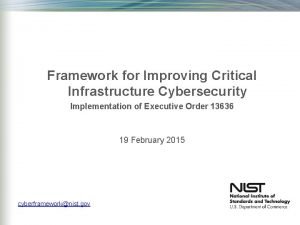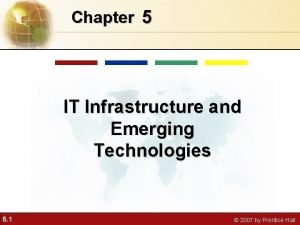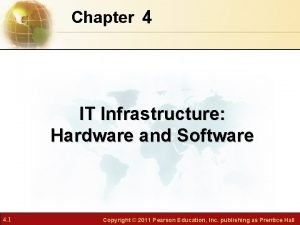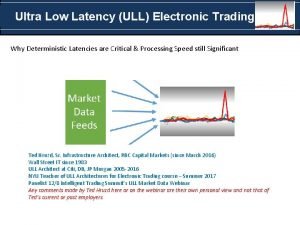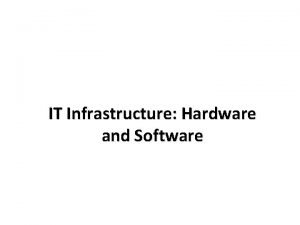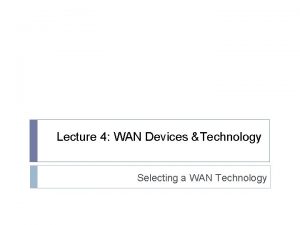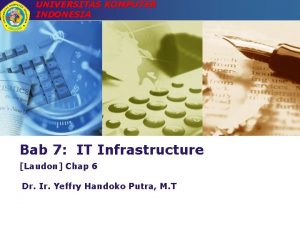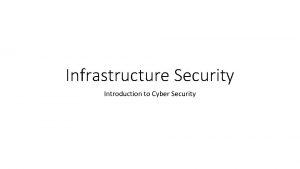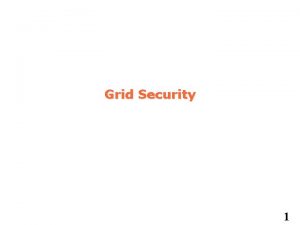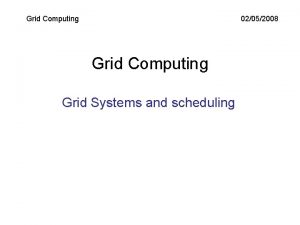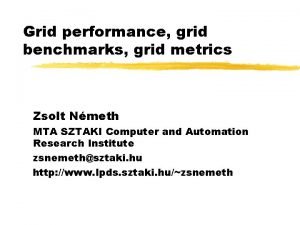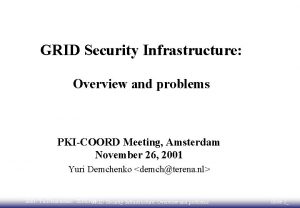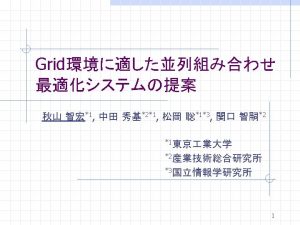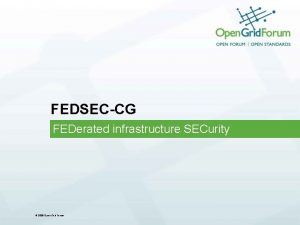Grid Security Grid Security A Grid Security Infrastructure































- Slides: 31


Grid Security

Grid Security • • • A: Grid Security Infrastructure (GSI) B: PKI and X. 509 certificates C: Proxy certificates D: The grid-mapfile E: Gsi-SSH

A: Grid Security Infrastructure (GSI)

GSI • Part of the Globus Toolkit (GTK) • Based on • PKI: Public Key Infrastructure • X. 509 Certificates • SSL (Secure Sockets Layer) protocol • Reference: www. globus. org/security

Why GSI? • To provide secure communication (authenticated and perhaps confidential) between elements of a computational Grid. • To support security across organizational boundaries, thus prohibiting a centrally-managed security system. • To support "single sign-on" for users of the Grid, including delegation of credentials for computations that involve multiple resources and/or sites.

B: PKI and X. 509 Certificates

PKI: Public Key Infrastructure • User (or entity) gets a related key pair: • one private key, known only to the user • one public key, distributable to the world • A message encrypted with one key requires the other key for decryption

Key Reciprocity • Data encrypted using the public key requires the private key for decryption. • If you know my public key, you can send me via an open channel a message only I can read. • Data encrypted using the private key requires the public key for decryption. • If my public key decrypts an encrypted message I have sent via an open channel, then only I could have sent it.

How Keys Get Around • Public keys can be freely distributed • Allows messages to be encrypted just for you. • Your private key doesn’t get around. • Period. That’s why it’s private.

X. 509 Certificates • Keys can be distributed as encapsulated in an X. 509 certificate. • The X. 509 certificate associates the public key with a qualified name. • The X. 509 certificate is also signed by a trusted issuer. • You saw one in Lab 1.

Who Issues a Certificate? • A certificate authority (CA) is a trusted entity who signs and issues X. 509 credentials • Examples: NCSA Alliance, DOEgrid CA • In the so-called “real world”: Veri. Sign • Each credential identifies its CA

X. 509 Certificate = “License” • • Identifies you and your institution Can’t be self-created Created for you by your institution Getting one isn’t an instantaneous process

What’s in an X. 509 Certificate? • • • Entity’s qualified name Entity’s public key Name of the issuing CA Signature of issuing CA Validity dates (start and end dates) Other stuff — version information, etc.

Qualified Name • Person’s name • Institution • Country C=US, O=National Center for Supercomputing Applications, CN=Edward N. Bola

Variations on the Theme • Qualified Name • Distinguished Name • Subject Name, Subject • You say “eether” I say “eyether” • Note that there are variations on the syntax; your format may not exactly match this • You say “potato” I say “potahto”

How do you inspect a certificate? • Utility for seeing information encapsulated in a certificate: grid-cert-info

The Certificate File Itself • Is stored in your ~/. globus directory • “usercert. pem” is the public key • File permissions = -rw-r----- • “userkey. pem” is the private key • File permissions = -r---- • Don’t chmod these, by the way; utilities like GSI-SSH check them out

Host Certificates • Certs aren’t just for users any more • Grid hosts also have certificates • Stored in /etc/grid-security • “hostcert. pem” • “hostkey. pem”

C: Proxy Certificates

Why Use Proxy Certificates? • A certificate usually lasts a year • If it’s stolen, it’s still good for the rest of the year • unless it’s revoked by being placed on a certificate revocation list (CRL) • And your utility actually checks the CRL. • With any frequency • A proxy certificate usually lasts 12 hours • Minimizes the possible mischief

grid-proxy-init • Asks for your grid passphrase • Stored in /tmp/x 509 up_u. XXXX • Where XXXX is your uid. • You’ve already seen this in Lab 1.

grid-proxy-info Queries the proxy certificate, not the “real” certificate subject issuer identity type strength path timeleft : : : : […] […] full legacy globus proxy 512 bits /tmp/x 509 up_u 506 11: 57: 31

grid-proxy-destroy • Destroys the proxy. • That’s about as simple as it gets.

D: grid-mapfile

grid-mapfile • Text file residing on a given host • /etc/grid-security/grid-mapfile • Associates accounts on that host to qualified names as they appear in the X. 509 certificates

Example gridmap-file entry "/O=Grid/OU=Globus. Test/OU=simple. CAgrids 3. ncsa. uiuc. edu/OU=localdomain/CN=Bob Test" btest

gsi-ssh • Grid-secure ssh utility • Modified version of Open. SSH using GSI

Lab: Security

Lab: Security • In this lab: • • How to get information about your certificate How to create (and destroy) proxy certificates How to use SSH without a password via GSI-SSH How to use My. Proxy to register a proxy certificate

Credits • Portions of this presentation were adapted from the following sources: • Gry. Phy. N Grid Summer Workshop • NEESgrid Sysadmin Workshop
 Grid security infrastructure
Grid security infrastructure Ogsa in grid computing
Ogsa in grid computing Open grid service infrastructure
Open grid service infrastructure Grid computing infrastructure
Grid computing infrastructure European grid infrastructure
European grid infrastructure Critical infrastructure security coordination centre
Critical infrastructure security coordination centre Homeland security infrastructure program
Homeland security infrastructure program Private secuirty
Private secuirty Land grid array vs pin grid array
Land grid array vs pin grid array Grid computing security
Grid computing security Infrastructure consortium for africa
Infrastructure consortium for africa Big data test infrastructure
Big data test infrastructure Nist cybersecurity framework roadmap
Nist cybersecurity framework roadmap Explicit knowledge examples
Explicit knowledge examples Service mesh
Service mesh Microsoft infrastructure optimization
Microsoft infrastructure optimization Chapter 5 it infrastructure and emerging technologies
Chapter 5 it infrastructure and emerging technologies E business infrastructure
E business infrastructure Sherwin williams murray
Sherwin williams murray Hardware and software infrastructure
Hardware and software infrastructure Privilege management infrastructure
Privilege management infrastructure Enterprise architecture metrics
Enterprise architecture metrics Ull trading network
Ull trading network Infrastructure project prioritisation matrix
Infrastructure project prioritisation matrix Hardware and software infrastructure
Hardware and software infrastructure Green infrastructure
Green infrastructure Cisco uci
Cisco uci Infrastructure delivery management
Infrastructure delivery management It infrastructure strategy example
It infrastructure strategy example What is a private wan
What is a private wan It infrastructure ecosystem
It infrastructure ecosystem National health information infrastructure
National health information infrastructure
